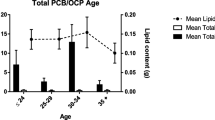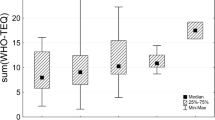Abstract
Fifty-four individual human milk samples from 50 mothers (20 Mohawks and 30 controls) were analyzed for four non-ortho- and eight mono-ortho-substituted polychlorinated biphenyls (PCBs). Mean total coplanar PCBs concentrations were 49 ng/g and 55 ng/g lipid for Mohawk and control women, respectively. A statistical evaluation of all analytical data reveals no significant difference of total coplanar PCB level between Mohawk and control women. The level of these contaminants is influenced by the age of the mother, number of breastfed children, and length of nursing period. Older women, primiparae, and cigarette smokers had higher levels of coplanar PCBs. In general, women had higher levels of coplanar PCBs in the first lactation and in the earlier samples of a given lactation, while levels declined both with duration of breast-feeding and with number of children nursed.
The contribution of individual non-ortho- and mono-ortho-substituted PCB congeners to the total calculated toxic equivalent values (ΣTEQ) was assessed for the breast milk samples. The levels of polychlorinated dibenzo-p-dioxins (PCDDs) and polychlorinated dibenzofurans (PCDFs) in human milk of pooled specimens from Los Angeles, California and Binghamton, New York, widely separate cities in the United States (Schecter et al. 1989), were presented for reference purpose. The main contributions to the ΣTEQ were PCB congeners #118 (25.8 pg/g lipid), #126 (25 pg/g lipid), #105 (10.8 pg/g lipid), and #156 (7.4 pg/g lipid). Collectively, these compounds accounted for 70% of the ΣTEQ values. Based on the TEFs proposed by Safe (1990), the overall TEQs calculated for the monitored PCBs, were about five times those due to total PCDD/Fs.
Similar content being viewed by others
References
Ahlborg U, Håkansson H, Waern F, Hanberg A (1988) Nordisk Dioxinriskbedömning, Nordiska Ministerrådet, K436–1benhavn, Denmark, ISBN (S) 91 7996 054 5
Bush B, Streeter RW, Sloan RJ (1989) Polychlorobiphenyl (PCB) congeners in striped bass (Morone saxatilis) from marine and estuarine waters of New York State determined by capillary gas chromatography. Arch Environ Contam Toxicol 19:49–61
Dewailly E, Weber JP, Gingras S, Laliberté C (1991) Coplanar PCBs in human milk in the Province of Québec, Canada: Are they more toxic than dioxin for breast fed infants? Bull Environ Contam Toxicol 47:491–498
Di Domenico A, Turrio Baldassarri L (1990) Levels of polychlorobiphenyls (PCBs), polychlorodibenzodioxins (PCDDs) and polychlorodibenzofurans (PCDFs) in human milk. Ann Ist Super Sanita 26:141–154
Drijver M, Duijkers TJ, Kromhout D (1988) Determinants of polychlorinated biphenyls (PCBs) in human milk. Acta Paediatr Scand 77:30–36
Duarte-Davidson R, Harrad SJ, Allen Sc, Jones KC (1992) The relative contribution of individual PCBs, PCDDs and PCDFs to toxic equivalent values derived for bulked human breast milk samples from the UK. Chemosphere 25:1653–1663
Fitzgerald EF, Hwang SA, Brix KA, Bush B, Quinn J, Cook K (1992) Chemical contaminants in the milk of Mohawk women from Akwesasne, GM Report, Albany, NY
Flint RW, Vena J (1991) Human health risks from chemical exposure: The Great Lakes ecosystem. Lewis Publishers, Chelsea, MI
Hong CS, Bush B, Xiao J, Fitzgerald E (1992) Isolation and determination of mono-ortho and non-ortho substituted PCBs (coplanar PCBs) in human milk by HPLC porous graphitic carbon and GC/ECD. Chemosphere 24(4):465–473
Jensen AA (1987) Polychlorinated biphenyls (PCBs), polychlorodibenzodioxins (PCDDs) and polychlorodibenzofurans (PCDFs) in human milk, blood and adipose tissue. Sci Total Environ 64:259–293
Knox JH, Kaur BJ (1986) Structure and performance of porous graphitic carbon in liquid chromatography. Chromatogr 352:3–25
Matsueda T, Iida T, Hirakawa H, Fukamachi K, Tokiwa H, Nagayama J (1993) Toxic evaluation of PCDDs, PCDFs and coplanar PCBs in breast-fed babies of yusho and healthy mothers. Chemosphere 27(1–3):187–194
NATO (1988) Pilot study on international information exchange on dioxins and related compounds scientific basis for the development of the international toxicity equivalency factor (I-TEF) method of risk assessment for complex mixtures of dioxins and related compounds. NATO: North Atlantic Treaty Organization Committee on the Challenges of Modern Society, Brussels Ed. 176
Norén K, Lundén A (1991) Trend studies of polychlorinated biphenyls, dibenzo-p-dioxins and dibenzofurans in human milk. Chemosphere 23:1895–1901
Safe S (1990) Polychlorinated biphenyls (PCBs), dibenzo-p-dioxins (PCDDs), dibenzofurans (PCDFs), and related compounds: Environmental and mechanistic considerations which support the development of toxic equivalency factors (TEFs). Crit Rev Toxicol 21(1):51–88
SAS Institute Inc (1990) SAS user's guide: Statistics, version 6, edition 4, Cary, NC
Schecter A, Fürst P, Papke O, Ball M, Hoang LCD, Quynh T, Phoung NTN, Beim A, Vlasov B, Chongchet V, Constable JD, Charles K (1991) Dioxins, dibenzofurans and selected chlorinated organic compounds in human milk and blood from Cambodia, Germany, Thailand, the U.S.A., the U.S.S.R., and Vietnam. Chemosphere 23(11–12):1903–1912
Schecter A, Fürst P, Ryan JJ, Fürst C, Meemken HA, Groebel W, Constable J, Vu D (1989) Polychlorinated dioxin and dibenzofuran levels from human milk from several locations in the United States, Germany, and Vietnam. Chemosphere 19(1–6):979–984
Stone WB, Jock K, Gradoni PB (1991) Chemical contaminants in wildlife from the Mohawk Nation at Akwesasne and the vicinity of the General Motors Corporation/Central Foundry Division, Massena, NY plant. New York State Department of Environmental Conservation, Albany.
Voogt PD, Well DE, Reutergardh L, Brinkman VA (1990) Review: Biological activity determination and occurrence of planar, mono-and di-ortho PCBs. Int J Environ Anal Chem 40:1–46
Author information
Authors and Affiliations
Rights and permissions
About this article
Cite this article
Hong, C.S., Xiao, J., Casey, A.C. et al. Mono-ortho- and non-ortho-substituted polychlorinated biphenyls in human milk from Mohawk and control women: Effects of maternal factors and previous lactation. Arch. Environ. Contam. Toxicol. 27, 431–437 (1994). https://doi.org/10.1007/BF00213183
Received:
Revised:
Issue Date:
DOI: https://doi.org/10.1007/BF00213183




